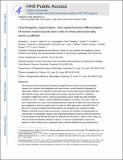| dc.contributor.author | Larson, Benjamin | |
| dc.contributor.author | Yu, Sarah N. | |
| dc.contributor.author | Park, Hyoungshin | |
| dc.contributor.author | Wu, Patrick B. | |
| dc.contributor.author | Langer, Robert S | |
| dc.contributor.author | Freed, Lisa E | |
| dc.date.accessioned | 2020-08-25T15:37:44Z | |
| dc.date.available | 2020-08-25T15:37:44Z | |
| dc.date.issued | 2019-08 | |
| dc.identifier.issn | 1932-7005 | |
| dc.identifier.issn | 1932-6254 | |
| dc.identifier.uri | https://hdl.handle.net/1721.1/126797 | |
| dc.description.abstract | The development of mechanically functional cartilage and bone tissue constructs of clinically relevant size, as well as their integration with native tissues, remains an important challenge for regenerative medicine. The objective of this study was to assess adult human mesenchymal stem cells (MSCs) in large, three-dimensionally woven poly(ε-caprolactone; PCL) scaffolds in proximity to viable bone, both in a nude rat subcutaneous pouch model and under simulated conditions in vitro. In Study I, various scaffold permutations—PCL alone, PCL-bone, “point-of-care” seeded MSC-PCL-bone, and chondrogenically precultured Ch-MSC-PCL-bone constructs—were implanted in a dorsal, ectopic pouch in a nude rat. After 8 weeks, only cells in the Ch-MSC-PCL constructs exhibited both chondrogenic and osteogenic gene expression profiles. Notably, although both tissue profiles were present, constructs that had been chondrogenically precultured prior to implantation showed a loss of glycosaminoglycan (GAG) as well as the presence of mineralization along with the formation of trabecula-like structures. In Study II of the study, the GAG loss and mineralization observed in Study I in vivo were recapitulated in vitro by the presence of either nearby bone or osteogenic culture medium additives but were prevented by a continued presence of chondrogenic medium additives. These data suggest conditions under which adult human stem cells in combination with polymer scaffolds synthesize functional and phenotypically distinct tissues based on the environmental conditions and highlight the potential influence that paracrine factors from adjacent bone may have on MSC fate, once implanted in vivo for chondral or osteochondral repair. | en_US |
| dc.description.sponsorship | National Institutes of Health (U.S.) (Grants R42 AR055404, P41 EB021911, P30 AR057235, P30 AR073752, OD10707)) | en_US |
| dc.description.sponsorship | National Cancer Institute (U.S.) (Grant P30CA014051) | en_US |
| dc.language.iso | en | |
| dc.publisher | Wiley | en_US |
| dc.relation.isversionof | 10.1002/TERM.2899 | en_US |
| dc.rights | Creative Commons Attribution-Noncommercial-Share Alike | en_US |
| dc.rights.uri | http://creativecommons.org/licenses/by-nc-sa/4.0/ | en_US |
| dc.source | PMC | en_US |
| dc.title | Chondrogenic, hypertrophic, and osteochondral differentiation of human mesenchymal stem cells on three‐dimensionally woven scaffolds | en_US |
| dc.type | Article | en_US |
| dc.identifier.citation | Larson, Benjamin L. et al. “Chondrogenic, hypertrophic, and osteochondral differentiation of human mesenchymal stem cells on three‐dimensionally woven scaffolds.” Journal of Tissue Engineering and Regenerative Medicine, 13, 8 (August 2019): 1453–1465 © 2019 The Author(s) | en_US |
| dc.contributor.department | Massachusetts Institute of Technology. Institute for Medical Engineering & Science | en_US |
| dc.contributor.department | Massachusetts Institute of Technology. Department of Biological Engineering | en_US |
| dc.contributor.department | Koch Institute for Integrative Cancer Research at MIT | en_US |
| dc.relation.journal | Journal of Tissue Engineering and Regenerative Medicine | en_US |
| dc.eprint.version | Author's final manuscript | en_US |
| dc.type.uri | http://purl.org/eprint/type/JournalArticle | en_US |
| eprint.status | http://purl.org/eprint/status/PeerReviewed | en_US |
| dc.date.updated | 2020-08-24T13:16:06Z | |
| dspace.date.submission | 2020-08-24T13:16:08Z | |
| mit.journal.volume | 13 | en_US |
| mit.journal.issue | 8 | en_US |
| mit.license | OPEN_ACCESS_POLICY | |
| mit.metadata.status | Complete | |
